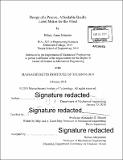| dc.contributor.advisor | Alexander H. Slocum. | en_US |
| dc.contributor.author | Johnson, Hilary Anna | en_US |
| dc.contributor.other | Massachusetts Institute of Technology. Department of Mechanical Engineering. | en_US |
| dc.date.accessioned | 2018-06-21T17:52:08Z | |
| dc.date.available | 2018-06-21T17:52:08Z | |
| dc.date.copyright | 2018 | en_US |
| dc.date.issued | 2018 | en_US |
| dc.identifier.uri | http://hdl.handle.net/1721.1/116486 | |
| dc.description | Thesis: S.M., Massachusetts Institute of Technology, Department of Mechanical Engineering, 2018. | en_US |
| dc.description | Cataloged from PDF version of thesis. | en_US |
| dc.description | Includes bibliographical references (pages 93-96). | en_US |
| dc.description.abstract | Braille labels are a simple technology that can enable people with blindness to independently identify objects and spaces in their workplaces, homes and schools. For children learning to read and write, braille labels on their toys and objects in the home and at school could catalyze learning by helping them to associate written words with physical objects. For an adult, identifying objects such as file folders, boxes, and medications is a functional skill essential in the workplace. Labels on these objects leads to an increase in daily efficiency. Yet, even though braille labels present the potential for increased independence and efficiency in the lives of people with blindness, there is no label maker on the market that meets the requirements of users. The goal of this thesis is to design a precise, affordable, language independent, personal braille label maker as a tool for the blind.
The work presented couples methods and tools from both deterministic design and human centered design philosophies. This integrated methodology drove the final design to meet both the precision and human requirements. The two most critical modules in the device are the braille dot embossing flexures and the braille cell indexing ratchet, which both require precision to meet international braille dot standards for the geometry and spacing. This device is designed to address the needs of Indian users as a beachhead market because of their desire for independence and employment. Furthermore, an educational focus on braille literacy for people with blindness in India motivates the use of this device. The result of this thesis is a braille label making device with precision alignment between the embossing punch and die and indexing of 6.2 mm, that creates durable braille labels on Scotch MagicTM Tape. The device form factor allows users to independently emboss each of the six dots so that labels can be written in any of the 133 braille languages that exist worldwide. Comprised of only six parts, the entire device is injection moldable out of ABS plastic, which lowers both the variable and fixed costs of part production and mold tooling. | en_US |
| dc.description.statementofresponsibility | by Hilary Anna Johnson. | en_US |
| dc.format.extent | 100 pages | en_US |
| dc.language.iso | eng | en_US |
| dc.publisher | Massachusetts Institute of Technology | en_US |
| dc.rights | MIT theses are protected by copyright. They may be viewed, downloaded, or printed from this source but further reproduction or distribution in any format is prohibited without written permission. | en_US |
| dc.rights.uri | http://dspace.mit.edu/handle/1721.1/7582 | en_US |
| dc.subject | Mechanical Engineering. | en_US |
| dc.title | Design of a precise, affordable braille label maker for the blind | en_US |
| dc.type | Thesis | en_US |
| dc.description.degree | S.M. | en_US |
| dc.contributor.department | Massachusetts Institute of Technology. Department of Mechanical Engineering | |
| dc.identifier.oclc | 1036985512 | en_US |
